铝合金船舶
船用铝合金板材指标
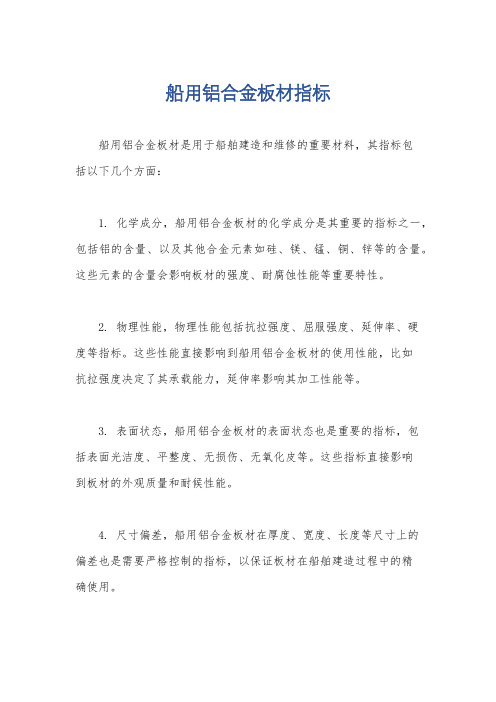
船用铝合金板材指标
船用铝合金板材是用于船舶建造和维修的重要材料,其指标包
括以下几个方面:
1. 化学成分,船用铝合金板材的化学成分是其重要的指标之一,包括铝的含量、以及其他合金元素如硅、镁、锰、铜、锌等的含量。
这些元素的含量会影响板材的强度、耐腐蚀性能等重要特性。
2. 物理性能,物理性能包括抗拉强度、屈服强度、延伸率、硬
度等指标。
这些性能直接影响到船用铝合金板材的使用性能,比如
抗拉强度决定了其承载能力,延伸率影响其加工性能等。
3. 表面状态,船用铝合金板材的表面状态也是重要的指标,包
括表面光洁度、平整度、无损伤、无氧化皮等。
这些指标直接影响
到板材的外观质量和耐候性能。
4. 尺寸偏差,船用铝合金板材在厚度、宽度、长度等尺寸上的
偏差也是需要严格控制的指标,以保证板材在船舶建造过程中的精
确使用。
总的来说,船用铝合金板材的指标涵盖了化学成分、物理性能、表面状态和尺寸偏差等多个方面,这些指标的合理控制对于保证船
用铝合金板材的质量和性能至关重要。
2024年铝合金船舶市场需求分析

铝合金船舶市场需求分析引言铝合金作为一种轻质高强度的材料,在船舶制造领域具有广泛的应用前景。
本文将对铝合金船舶市场需求进行分析,并探讨其未来发展趋势。
1. 铝合金船舶的优势铝合金船舶相比传统钢质船舶具有以下优势:- 轻质高强度:铝合金船舶重量轻,可以提高船舶的载货能力和燃油效率。
- 耐蚀性强:铝合金具有良好的耐腐蚀性能,可以减少维护和修复成本。
- 易于加工:铝合金易于切割、焊接和成型,可以加快船舶制造周期。
- 环保可持续:铝合金可100%回收再利用,符合可持续发展理念。
2. 铝合金船舶市场需求2.1 铝合金快艇随着旅游业和水上运动的发展,对快艇的需求不断增加。
铝合金材料的轻量化和高强度使其成为制造快艇的理想选择。
铝合金快艇具有快速、稳定和节能的特点,在休闲娱乐和海上运输领域有广阔的市场需求。
2.2 铝合金渔船渔业是世界各国重要的经济产业之一,传统的木质渔船逐渐被铝合金渔船取代。
铝合金渔船具有良好的耐腐蚀性和抗风浪能力,可以提高渔民的工作效率和安全性。
随着渔业的发展和国际渔业政策的调整,铝合金渔船市场需求将不断增加。
2.3 铝合金游艇随着人们对海上休闲活动的需求增加,铝合金游艇市场呈现出快速增长的趋势。
铝合金游艇具有舒适性、安全性和环保性能优势,能够满足高端消费者对奢华船舶的需求。
铝合金游艇市场前景广阔,在富裕地区市场需求有望持续增长。
2.4 其他市场需求除了上述几个主要市场需求外,铝合金船舶还可以应用于海事勘测、海洋科学研究、海洋资源开发等领域。
随着科技的不断进步和需求的不断变化,铝合金船舶市场需求将继续扩大。
3. 发展趋势3.1 技术创新未来铝合金船舶市场将迎来技术创新的浪潮。
通过改进铝合金材料的合金配方和制造工艺,提高其强度和耐腐蚀性能,进一步拓宽其应用领域。
3.2 自动化和智能化随着船舶自动化和智能化技术的发展,铝合金船舶将更好地满足用户需求。
自动驾驶、智能船舶监控和管理系统等技术将推动铝合金船舶市场发展。
铝合金在船舶上的应用实例
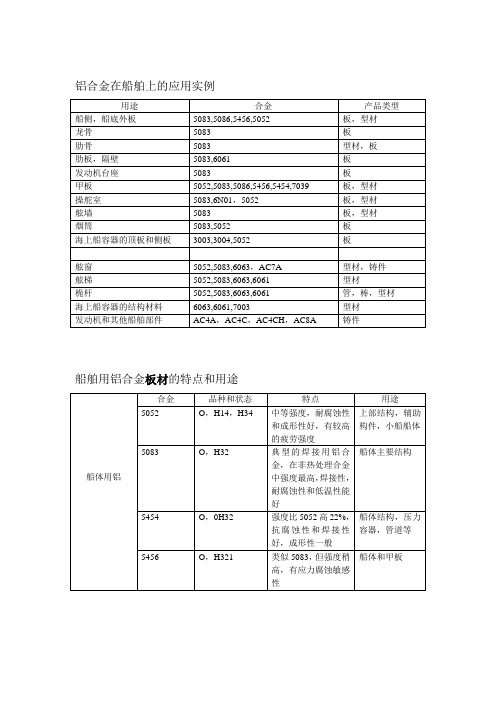
O,0H32
强度比5052高22%,抗腐蚀性和焊接性好,成形性一般
船体结构,压力容器,管道等
5456
O,H321
类似5083,但强度稍高,有应力腐蚀敏感性
船体和甲板
类别
合金
状态
特点
用途
舣装用铝
1050,1200
H112, O,H12,H24
强度低,加工性,焊接性和耐腐蚀性好,表面处理性高
内装修
铝合金在船舶上的应用实例
用途
合金
产品类型
船侧,船底外板
5083,5086,5456,5052
板,型材
龙骨
5083
板
肋骨
5083
型材,板
肋板,隔壁
5083,6061
板
发动机台座
5083
板
甲板
5052,5083,5086,5456,5454,7039
板,型材
操舵室
5083,6N01,5052
板,型材
舷墙
AC4A,AC4C,AC4CH,AC8A
铸件
船舶用铝合金板材的特点和用途
船体用铝
合金
品种和状态
特点
用途
5052
O,H14,H34
中等强度,耐腐蚀性和成形性好,有较高的疲劳强度
上部结构,辅助构件,小船船体
5083
O,H32
典型的焊接用铝合金,在非热处理合金中强度最高,焊接性,耐腐蚀性和低温性能好
船体主要结构
3033,3203
H112,O,H12
强度比1100高10%,成形性,焊接性,和耐腐蚀性好
内装,液化石油气罐的顶板和侧板
油船:长60.8米,可运载1160吨石油的油船船壳体使用铝材情况:
铝合金船舶建造工艺

铝合金船舶建造工艺引言:随着船舶工业的发展,铝合金船舶的建造工艺也日益成熟。
铝合金船舶以其轻质、高强度、耐腐蚀等特点,在船舶建造领域得到广泛应用。
本文将介绍铝合金船舶建造的工艺过程和相关技术。
一、铝合金船舶建造的材料选择铝合金船舶建造的首要任务是选择合适的材料。
目前常用的铝合金材料有铝铜合金、铝镁合金和铝锰合金等。
选材时需要考虑船舶的用途、承载能力和耐腐蚀性能等因素。
材料的选择直接影响到船舶的性能和使用寿命。
二、铝合金船舶建造的设计与制造铝合金船舶的设计与制造过程包括以下几个关键步骤:1. 设计方案:根据船舶的用途和性能要求,确定合适的设计方案。
设计方案包括船体结构、船体尺寸、船舱布局等。
2. 材料加工:将选定的铝合金材料进行加工,包括切割、锻造、挤压等工艺。
加工过程需要精确控制温度和压力,以确保材料的性能和形状。
3. 船体组装:将加工好的铝合金材料按照设计方案进行组装。
船体组装需要保证结构的牢固性和密封性,以及各个部件之间的协调配合。
4. 焊接和连接:对于大型铝合金船舶,常采用焊接和连接技术将各个部件连接起来。
焊接和连接工艺需要严格控制焊缝的质量,以确保船体的强度和密封性。
5. 表面处理:铝合金船舶的表面处理包括除锈、防腐、喷涂等工艺。
表面处理能够延长船舶的使用寿命,提高船体的耐腐蚀性能。
6. 设备安装:将船舶所需的各种设备安装到船体上,包括动力装置、导航设备、通信设备等。
设备安装需要考虑船舶的结构和重心平衡等因素。
三、铝合金船舶建造的质量控制铝合金船舶建造过程中需要进行严格的质量控制,以确保船舶的安全和可靠性。
质量控制包括以下几个方面:1. 材料检测:对于每批铝合金材料进行化学成分分析和力学性能测试,以确保材料的质量符合要求。
2. 焊接检测:对焊接接头进行无损检测,以发现焊缝的缺陷和裂纹等问题。
3. 结构检测:对船体的结构进行强度和稳定性分析,以确保船舶在各种工况下的安全性能。
4. 耐腐蚀检测:对船体表面的防腐涂层进行检测,以确保船舶具有良好的耐腐蚀性能。
铝合金船的建造

弯曲与成型
利用专业设备对铝合金材料进行弯曲和成型处理,形成所需 的船体结构。
铝合金材料的连接方式
焊接工艺
采用氩弧焊等焊接工艺,将船体各部分铝合金材料牢固地连接在一起,确保船体 的整体强度。
螺丝连接
对于一些小部件或需要频繁拆卸的部位,可以采用螺丝连接的方式,方便维修和 更换。
03
铝合金船的建造工艺
铝合金具有优良的导热性 能,能够快速地散发热量, 有利于船体的散热。
良好的塑性
铝合金易于加工成各种形 状和结构,适合用于制造 复杂的船体结构和部件。
铝合金船的力学性能
高强度
良好的焊接性能
铝合金经过适当处理后,具有较高的 强度和刚度,能够承受较大的负载和 压力。
铝合金具有良好的焊接性能,能够方 便地进行焊接和连接。
船体建造流程
船体放样
根据结构设计图纸,进行船体放样, 确定各个部件的形状和尺寸。
部件加工
对船体各个部件进行加工,包括切割、弯曲、 钻孔等,确保部件的精度和形状符合设计要求。
船体组装
将加工好的船体部件进行组装,通过焊接、螺 栓连接等方式将各部件连接成一个完整的船体。
焊接材料选择
根据船体结构和材料要求,选择合适 的焊接材料,确保焊接质量和强度。
质量检测
对船舶进行全面的质量检测,确保船舶满足设计 要求和安全标准。
交付使用
完成船舶的试航和验收,将货船交付给客户并办理相关 手续。
案例二:高速铝合金游艇的设计与制造
设计阶段
结合市场需求和客户个性化要求, 进行外观和性能设计,注重轻量化 、高速性和舒适性。
材料选择
选用高强度铝合金材料,通过精密 的加工和焊接工艺,确保游艇的结 构强度和稳定性。
船舶等级材质

船舶等级材质船舶等级材质是指用于船舶建造的材料,其质量和性能直接影响船舶的安全性、耐久性和航行性能。
船舶等级材质通常包括钢材、铝合金、复合材料等多种类型。
本文将从这些方面对船舶等级材质进行介绍。
一、钢材钢材是船舶建造中最常用的材料之一。
根据船舶使用的不同部位和要求,钢材可以分为船体结构钢、船舶机械钢和船舶电气钢等。
船体结构钢应具有足够的强度和韧性,以承受船体的自重和外部载荷。
船舶机械钢主要用于制造推进系统、船舶设备和机械部件,要求具有良好的可焊性和耐磨性。
船舶电气钢则用于制造船舶电气设备和电气系统,需要具备良好的导电性和耐腐蚀性。
二、铝合金铝合金因其优良的重量比和抗腐蚀性而被广泛应用于船舶建造。
船舶中常使用的铝合金包括铝镁合金、铝锰合金和铝铜合金等。
铝合金的低密度和高强度使船舶在保持良好的航行性能的同时,减轻了自重,提高了载重能力。
此外,铝合金还具有良好的耐腐蚀性,可以减少船体的维护工作。
三、复合材料复合材料由两种或两种以上的材料组合而成,常见的有碳纤维复合材料和玻璃纤维复合材料。
船舶中使用的复合材料具有重量轻、强度高、抗腐蚀性好等特点。
此外,复合材料还具有优良的隔热性能和吸音性能,可以提高船舶的舒适性和安全性。
四、其他材料除了上述常见的材料外,船舶建造中还会使用一些特殊的材料。
例如,船舶的甲板通常会使用木材,因为木材具有良好的防滑性和吸震性能。
另外,一些船舶的船体外壳会使用纤维增强塑料,因为这种材料具有良好的耐腐蚀性和耐磨性。
总结船舶等级材质是保证船舶安全和性能的重要因素。
钢材、铝合金和复合材料是船舶建造中常用的材料,它们各自具有不同的特点和适用范围。
此外,船舶建造还会使用一些特殊的材料,以满足特定的要求。
船舶等级材质的选择应根据船舶的使用环境、功能和要求来确定,以确保船舶的安全性和可靠性。
铝合金 船 标准

铝合金船标准铝合金船简介船舶一直以来都是人们重要的交通工具,用于海上、河流等水域的运输和航行。
在过去,船舶主要是由传统的钢铁材料制成,但随着科技的发展和人们环保意识的提高,铝合金船开始逐渐受到关注。
铝合金船是指使用铝合金材料制造的船舶。
相比传统的钢铁船舶,铝合金船具有更轻、更强、更耐腐蚀的特点。
铝合金船的优势在于其重量轻,这使其在航行时能够更节约燃料,提高船舶的速度和安全性能。
此外,铝合金具有很高的抗腐蚀性能,能够很好地抵抗海水和环境中的腐蚀,从而延长船舶的使用寿命。
使用铝合金制造船舶的过程也较为先进和高效。
铝合金具有良好的加工性能,能够通过铆接、焊接等方式进行连接和组装,使得制造过程更加简便和快速。
此外,铝合金还具有很好的成型性能,能够满足各种形状和尺寸的船舶需求。
铝合金船的广泛应用范围,既包括商用船舶,也包括军事船舶。
商用船舶主要用于海上货物运输、客船、游艇等领域。
铝合金船舶在这些领域的应用主要体现在提高船舶的运载能力和航行速度,从而提高运输效率。
军事船舶主要用于海上巡逻、救援、军事行动等领域。
铝合金船在军事领域的应用主要体现在其轻便、灵活的特点,有利于船舶的机动性和战斗能力。
然而,铝合金船也存在一些缺点和挑战。
首先,铝合金船在抗冲击和抗碰撞方面的性能相对较差,需要对结构进行加固,以提高船舶的安全性能。
其次,铝合金船的制造成本相对较高,这主要是由于铝合金材料的价格较高以及制造工艺的复杂性导致的。
此外,铝合金船在一些极端条件下的应用仍然存在一定的技术挑战,需要进一步的研究和创新。
随着科技的不断进步和铝合金材料的发展,铝合金船在未来有着广阔的应用前景。
铝合金船的轻量化和耐腐蚀性能使其能够更好地适应船舶行业的发展需求。
同时,铝合金船也符合人们对环保和可持续发展的要求。
因此,铝合金船将成为未来航海时代的重要趋势。
综上所述,铝合金船作为一种新型船舶材料,具有轻便、强度高、耐腐蚀等优势。
它在商用船舶和军事船舶领域都有着广泛的应用。
现代铝合金画舫船种类
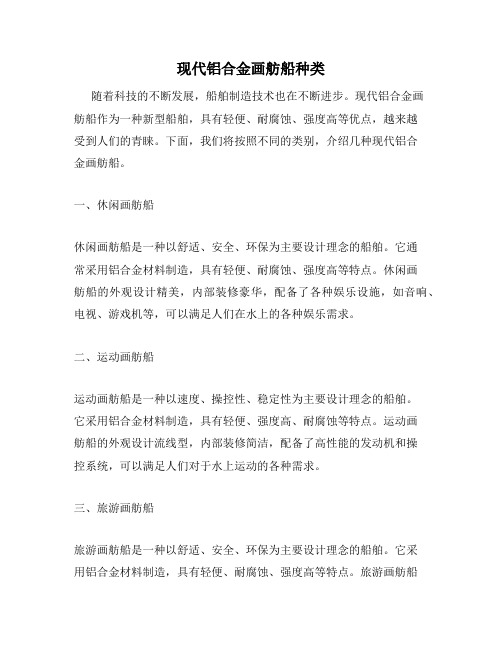
现代铝合金画舫船种类随着科技的不断发展,船舶制造技术也在不断进步。
现代铝合金画舫船作为一种新型船舶,具有轻便、耐腐蚀、强度高等优点,越来越受到人们的青睐。
下面,我们将按照不同的类别,介绍几种现代铝合金画舫船。
一、休闲画舫船休闲画舫船是一种以舒适、安全、环保为主要设计理念的船舶。
它通常采用铝合金材料制造,具有轻便、耐腐蚀、强度高等特点。
休闲画舫船的外观设计精美,内部装修豪华,配备了各种娱乐设施,如音响、电视、游戏机等,可以满足人们在水上的各种娱乐需求。
二、运动画舫船运动画舫船是一种以速度、操控性、稳定性为主要设计理念的船舶。
它采用铝合金材料制造,具有轻便、强度高、耐腐蚀等特点。
运动画舫船的外观设计流线型,内部装修简洁,配备了高性能的发动机和操控系统,可以满足人们对于水上运动的各种需求。
三、旅游画舫船旅游画舫船是一种以舒适、安全、环保为主要设计理念的船舶。
它采用铝合金材料制造,具有轻便、耐腐蚀、强度高等特点。
旅游画舫船的外观设计精美,内部装修豪华,配备了各种旅游设施,如餐厅、卧室、浴室等,可以满足人们在水上旅游的各种需求。
四、渔业画舫船渔业画舫船是一种以耐用、实用、经济为主要设计理念的船舶。
它采用铝合金材料制造,具有轻便、耐腐蚀、强度高等特点。
渔业画舫船的外观设计简洁,内部装修实用,配备了各种渔业设备,如渔网、渔具等,可以满足人们在水上捕鱼的各种需求。
总之,现代铝合金画舫船种类繁多,每种船舶都有其独特的设计理念和特点。
无论是休闲、运动、旅游还是渔业,都可以找到适合自己的画舫船。
相信随着科技的不断进步,现代铝合金画舫船将会越来越普及,为人们的生活带来更多的便利和乐趣。
船舶建造材料的选择与应用

船舶建造材料的选择与应用
船舶建造材料的选择与应用是一个关键的决策,直接影响船舶的性能、安全性和寿命。
以下是一些常见的船舶建造材料以及它们的应用:
1. 钢铁:钢铁是最常用的船舶建造材料之一,具有高强度、耐腐蚀和可塑性等优点。
钢铁通常用于船体的构造和船舶的主要部件,如船体结构、船底板和甲板等。
2. 铝合金:铝合金具有轻质、高强度和耐腐蚀性等特点,常用于建造高速船和小型船舶。
铝合金船舶通常具有更高的速度和较低的燃油消耗。
它们适用于近海和沿海运输。
3. 纤维复合材料:纤维复合材料是一种轻质、高强度和耐腐蚀的材料,由纤维增强物和树脂基体组成。
它们通常用于建造高速船和游艇,具有较低的重量和更好的燃油效率。
4. 木材:在一些传统的船舶建造中,木材仍然是一个重要的材料选择。
木材具有良好的抗冲击性和可塑性,适用于建造小型渔船、帆船和传统船只。
5. 聚合物材料:聚合物材料如聚乙烯、聚丙烯和聚氯乙烯等具有良好的耐腐蚀性和耐候性,常用于建造船舶的内部组件和管道系统。
船舶建造材料的选择取决于许多因素,包括船舶的用途、航行条件、
预算和可用资源等。
同时,船舶建造材料的选择也需要考虑到船舶的设计、结构和性能要求,以确保船舶的安全性和可靠性。
船舶铝合金上层建筑技术要求 标准

船舶铝合金上层建筑技术要求标准下载温馨提示:该文档是我店铺精心编制而成,希望大家下载以后,能够帮助大家解决实际的问题。
文档下载后可定制随意修改,请根据实际需要进行相应的调整和使用,谢谢!并且,本店铺为大家提供各种各样类型的实用资料,如教育随笔、日记赏析、句子摘抄、古诗大全、经典美文、话题作文、工作总结、词语解析、文案摘录、其他资料等等,如想了解不同资料格式和写法,敬请关注!Download tips: This document is carefully compiled by theeditor.I hope that after you download them,they can help yousolve practical problems. The document can be customized andmodified after downloading,please adjust and use it according toactual needs, thank you!In addition, our shop provides you with various types ofpractical materials,such as educational essays, diaryappreciation,sentence excerpts,ancient poems,classic articles,topic composition,work summary,word parsing,copy excerpts,other materials and so on,want to know different data formats andwriting methods,please pay attention!船舶铝合金上层建筑技术要求详解一、引言在现代船舶设计与建造中,铝合金因其轻质、高强度、耐腐蚀等特性,被广泛应用于船舶的上层建筑。
铝合金 船 标准

铝合金船标准引言:船舶是一种重要的交通工具,不仅常常用于快速、高效地人员和货物运输,而且在海洋科学研究、水下探测、资源开发等方面也扮演着重要角色。
在船舶的制造过程中,材料的选择和质量控制至关重要。
铝合金是一种常用的船舶材料,具有轻质、耐腐蚀、高强度等优点。
本文将介绍铝合金船的标准要求,以确保其制造过程和质量的合规性。
一、材料选择1.1 铝合金种类根据船舶的不同部位和作用,选择相应的铝合金种类。
船体结构一般采用高强度铝合金(如5000系列、6000系列、7000系列),船舶甲板、舱口等耐腐蚀部位采用耐海水腐蚀的合金(如5000系列、6000系列)。
1.2 材料性能要求铝合金船的材料应符合国家标准或国际协议中规定的性能要求,如抗拉强度、屈服强度、伸长率、硬度等指标。
船舶结构材料还需满足耐海水腐蚀和海洋环境应力腐蚀开裂等特殊要求。
1.3 材料质量控制在选用铝合金材料时,必须对每批材料进行质量检验,并确保其质量符合标准要求。
质检包括外观检查、化学成分分析、金相组织和力学性能测试等。
二、制造过程2.1 设计和制造依据铝合金船的设计和制造必须按照相关的标准、规范和规程进行,如国家标准、国际协议、船级社规范等。
设计依据包括结构设计规范、材料性能要求、可靠性要求、安全性要求等。
2.2 制造工艺控制在铝合金船制造过程中,应严格控制各项工艺参数,包括铝合金的熔化、铸造、锻造、轧制、焊接、表面处理等工艺。
各项工艺参数应符合相关标准,以确保船的强度和耐腐蚀性能。
2.3 焊接工艺铝合金船在制造过程中往往需要进行大量的焊接工艺,特别是船体结构的焊接。
焊接工艺应符合相关标准要求,包括焊接材料的选择、焊接工艺参数、焊接质量检验等。
2.4 表面处理为了增强铝合金船的耐腐蚀性能和外观质量,表面处理是必不可少的一步。
表面处理工艺包括除垢、清洗、阳极氧化、涂装等。
表面处理应符合相关标准要求,并进行品质检验。
三、质量控制3.1 检验和试验在制造过程中,应进行各类检验和试验,以确保铝合金船的质量符合标准要求。
铝合金在船上的应用场景

铝合金在船上的应用场景铝合金作为一种轻质高强度材料,具有优良的抗腐蚀性和可塑性,因此在船舶制造领域有着广泛的应用。
以下将从船体结构、装备设备和船舶配件三个方面,介绍铝合金在船上的具体应用场景。
首先是船体结构方面。
船体通常由多个舱室和舷侧构成,铝合金提供了一种重要的选择材料。
相比于传统的钢材,铝合金船体具有更高的强度,可以减轻船体自重。
这不仅能提高船舶的载重量,而且能降低燃油消耗量,提高燃油经济性。
此外,铝合金还具有较好的抗腐蚀性,能够延长船体的使用寿命。
因此,铝合金船体在游艇、快艇、船舶、潜水艇等领域得到广泛应用。
其次是装备设备方面。
船舶上有大量的装备设备需要使用铝合金材料来制造,例如舱口盖、天窗、推拿机、拖拉机、边沿托架等。
铝合金具有良好的可塑性,能够轻松加工成各种复杂形状,满足船舶上不同设备的需求。
此外,铝合金能够抵御海水的腐蚀,保证设备的正常运行。
在具体应用中,铝合金材料可以用于制造散热器、电缆桥架、推车等装备设备。
最后是船舶配件方面。
船舶上有众多的配件需要使用铝合金来制造,如甲板上的栏杆、梯子和舱口,以及舱室内的门窗和床架等。
铝合金具有轻质高强度的特点,使得这些配件具有较好的承载能力和抗风压能力。
此外,铝合金还具有优异的抗腐蚀性能,能够在恶劣的海洋环境中长期使用。
因此,船舶配件的铝合金材料广泛应用于船舶、游艇、渔船等领域。
虽然铝合金在船舶制造中有着广泛的应用,但它也存在一些不足之处。
首先,铝合金的价格相对较高,导致船舶制造成本增加。
其次,铝合金在大型船舶领域的应用受到一定的限制,因为相比较于钢材,铝合金的强度还有提升的空间。
此外,船舶制造领域的工艺和技术对铝合金的加工和连接提出了一定的要求。
总结来说,铝合金作为一种轻质高强度材料,具有优良的抗腐蚀性和可塑性,广泛应用于船舶制造领域。
它在船体结构、装备设备和船舶配件等方面发挥着重要的作用,提高了船舶的载重量、节约燃油、延长使用寿命。
但是,铝合金的价格较高,且其强度仍有进一步提升的空间,需要进一步改进和研究。
铝合金船和玻璃钢游艇对比的优缺点
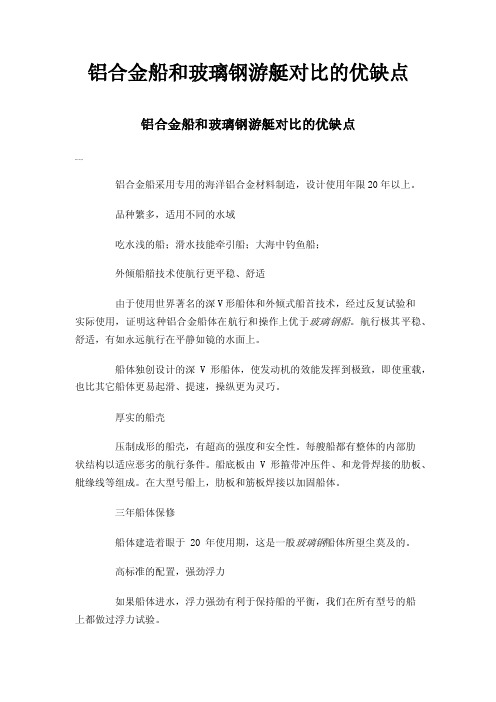
铝合金船和玻璃钢游艇对比的优缺点铝合金船和玻璃钢游艇对比的优缺点00铝合金船采用专用的海洋铝合金材料制造,设计使用年限20年以上。
品种繁多,适用不同的水域吃水浅的船;滑水技能牵引船;大海中钓鱼船;外倾船艏技术使航行更平稳、舒适由于使用世界著名的深V形船体和外倾式船首技术,经过反复试验和实际使用,证明这种铝合金船体在航行和操作上优于玻璃钢船。
航行极其平稳、舒适,有如永远航行在平静如镜的水面上。
船体独创设计的深V形船体,使发动机的效能发挥到极致,即使重载,也比其它船体更易起滑、提速,操纵更为灵巧。
厚实的船壳压制成形的船壳,有超高的强度和安全性。
每艘船都有整体的内部肋状结构以适应恶劣的航行条件。
船底板由V形箍带冲压件、和龙骨焊接的肋板、舭缘线等组成。
在大型号船上,肋板和筋板焊接以加固船体。
三年船体保修船体建造着眼于 20 年使用期,这是一般玻璃钢船体所望尘莫及的。
高标准的配置,强劲浮力如果船体进水,浮力强劲有利于保持船的平衡,我们在所有型号的船上都做过浮力试验。
完美的船尾你的伙伴想拥有完美的船尾。
船尾肋板是天才的工程设计,整个船体延伸至船尾下水平台。
对克服恶劣航行条件极为有益,对加速起滑及保持高航速滑行状态有利。
适合配置大功率发动机,这是一个令人喜爱的多用途船尾平台。
比玻璃钢船体更为优越,省油是最大优点比玻璃钢船轻,能提供更多的空间,有利于在水中行进,用汽车拖曳。
能更快地提速,滑行节省燃油,使用发动机的功率也较小。
铝合金刚度太强,难加工,成本价高,一般船东造不起玻璃钢用于造船有很多优点:1)质轻,高强,尤其它的比强度超过其他材料。
造船的船艇自身质量轻,可节省能源和提高航速,是理想的船艇制造材料。
2)耐腐蚀性能好,抗海生物附着如海蛎子不会吸附在表面上,比金属更适合制造船体。
3)无磁性,介电性能好。
微波穿透性好。
适宜制造扫雷艇,潜艇等军用舰艇。
4)可设计性好,可按照船舶结构,形状及各部分的要求。
通过选材,铺层,定向满足优化设计及产品强度要求。
铝合金材料在船舶与海洋工程装备中的应用

铝合金材料在船舶与海洋工程装备中的应用发布时间:2022-04-11T13:19:03.788Z 来源:《中国科技信息》2022年1月上作者:刘丁杰[导读] 在船舶的制造过程中,船舶制造公司应选择合理的材料,使其具有较强耐腐蚀性、韧性及较强的强度。
铝合金成了一种最佳的材料,被有效运用到制造过程中,使得船舶性能更佳。
随着当前海洋工程及船舶业飞速地发展,制造企业也加大了对新材料的研发力度,使轮船制造成本得到降低,凸显铝合金在整个海洋工程中的应用意义,使该行业能够稳步的发展。
本文对铝合金材料在船舶与海洋工程装备中的应用进行分析,以供参考。
江南造船(集团)有限责任公司刘丁杰摘要:在船舶的制造过程中,船舶制造公司应选择合理的材料,使其具有较强耐腐蚀性、韧性及较强的强度。
铝合金成了一种最佳的材料,被有效运用到制造过程中,使得船舶性能更佳。
随着当前海洋工程及船舶业飞速地发展,制造企业也加大了对新材料的研发力度,使轮船制造成本得到降低,凸显铝合金在整个海洋工程中的应用意义,使该行业能够稳步的发展。
本文对铝合金材料在船舶与海洋工程装备中的应用进行分析,以供参考。
关键词:铝合金材料;船舶;海洋工程;应用引言铝合金广泛应用于航空航天、汽车制造以及船舶制造等领域。
在动力不变的情况下,铝合金的质轻特点能够使船舶的速度更快。
铝合金船舶的建造工艺不同于一般钢质船,在下料切割和焊接等方面有着特殊要求。
因此,分析铝合金船舶的建造难点,并以主船体为钢质结构、上层建筑为铝合金的船舶为例,介绍钢-铝混合船舶的建造阶段划分,重点分析上层建筑的建造工艺及主船体与上层建筑之间的焊接工艺,对提高铝合金船舶的建造水平、促进水面舰艇以及渔政船的发展有着积极意义。
1铝合金在船舶和海洋工程应用的性能分析铝合金具有较强的耐腐蚀性、良好的焊接性和高强度,在船舶领域使用时能够处理各种复杂的航行环境。
一般来说,造船企业会选择铝镁合金、铝镁硅合金和铝锌镁合金,铝合金目前应用广泛。
某双体铝合金艇结构强度规范计算
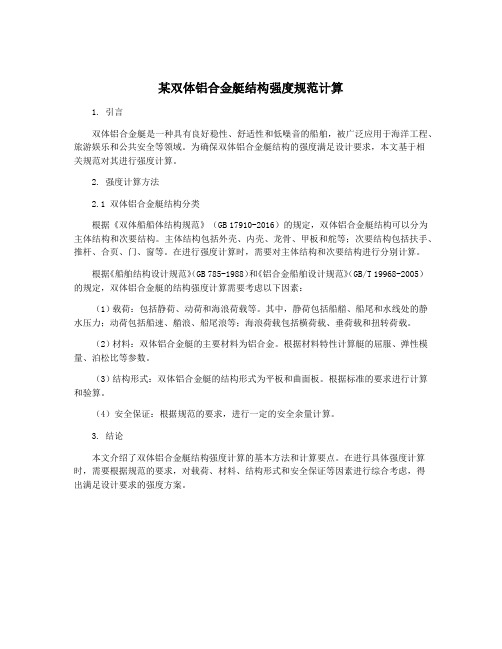
某双体铝合金艇结构强度规范计算
1. 引言
双体铝合金艇是一种具有良好稳性、舒适性和低噪音的船舶,被广泛应用于海洋工程、旅游娱乐和公共安全等领域。
为确保双体铝合金艇结构的强度满足设计要求,本文基于相
关规范对其进行强度计算。
2. 强度计算方法
2.1 双体铝合金艇结构分类
根据《双体船船体结构规范》(GB 17910-2016)的规定,双体铝合金艇结构可以分为主体结构和次要结构。
主体结构包括外壳、内壳、龙骨、甲板和舵等;次要结构包括扶手、推杆、合页、门、窗等。
在进行强度计算时,需要对主体结构和次要结构进行分别计算。
根据《船舶结构设计规范》(GB 785-1988)和《铝合金船舶设计规范》(GB/T 19968-2005)的规定,双体铝合金艇的结构强度计算需要考虑以下因素:
(1)载荷:包括静荷、动荷和海浪荷载等。
其中,静荷包括船艏、船尾和水线处的静水压力;动荷包括船速、艏浪、船尾浪等;海浪荷载包括横荷载、垂荷载和扭转荷载。
(2)材料:双体铝合金艇的主要材料为铝合金。
根据材料特性计算艇的屈服、弹性模量、泊松比等参数。
(3)结构形式:双体铝合金艇的结构形式为平板和曲面板。
根据标准的要求进行计算和验算。
(4)安全保证:根据规范的要求,进行一定的安全余量计算。
3. 结论
本文介绍了双体铝合金艇结构强度计算的基本方法和计算要点。
在进行具体强度计算时,需要根据规范的要求,对载荷、材料、结构形式和安全保证等因素进行综合考虑,得
出满足设计要求的强度方案。
铝合金船舶的腐蚀及防腐工艺

铝合金船舶的腐蚀及防腐工艺摘要:船舶铝合金是对各种类型的腐蚀金属材料,如化学环境,海水,大气,磨损和腐蚀。
因此,加强铝合金船舶的防腐蚀已成为造船业的重要组成部分。
本文简要介绍了铝合金船舶的腐蚀现状,分析了铝合金船舶防腐技术的现状,并概述了铝合金船舶未来的防腐技术。
关键词:铝合金船舶;腐蚀防护技术铝合金具有比重低、比强度高、耐海水腐蚀性好、无磁性、温度性能低等优点。
在造船业中,它越来越被认为是一种建筑材料。
使用铝合金作为船体材料,可以有效地减轻船舶重量,提高稳定性和速度,提高船舶的技术和战术性能。
铝和铝合金具有高活性化学性质,但它们的耐腐蚀性比钢好得多,因为它们可以与氧形成致密的被动氧化膜。
在船舶上使用时,铝合金或多或少地与海水接触,或暴露在海水飞沫和大气侵袭,导致一定程度的腐蚀。
铝合金的腐蚀是一个复杂的过程,取决于合金的环境和特性。
一、铝合金船舶的腐蚀情况对海洋环境的要求更高,对铝合金防腐蚀的要求更高。
在船舶中,各种部件暴露于不同的腐蚀环境中,船底主要受到海水浸没和水生生物粘附引起的自然腐蚀的影响。
水管上部主要受盐雾腐蚀和大气老化影响。
目前铝合金船的主要腐蚀条件如下:(1)船体腐蚀一般采用铝阳极牺牲涂料。
(2)空舱主要由裸铝制成,无保护涂层结构。
在检查了几艘船的空舱后,发现了广泛的腐蚀。
更明显的腐蚀通常发生在空舱地板与船壳板之间的接上。
(3)铝合金海水管对电偶腐蚀性。
(4)对某型艇进行专门的综合检查,发现更多艇艉板法兰明显的腐蚀现象,有些部件严重腐蚀甚至穿孔。
二、铝合金船舶的防腐1.防腐涂料。
广泛应用于船体及上部结构的防腐,其防腐效果取决于涂料、涂刷质量、施工环境等诸多因素。
在涂刷之前,通常在涂刷之前进行空泡实验。
防腐涂料必须得到船级社的批准。
涂料不应含有惰性金属,如铜,铅或导电材料,如石墨,以防止电化学腐蚀或其他类型的铝合金腐蚀。
在施工过程中应注意以下几点:(1)喷涂应采用真空喷涂,喷涂工艺可用于小面积的涂装和涂刷;(2)涂覆前应对涂覆表面进行适当的清洁,特别是焊缝和侧角,以避免表面粉尘等污染物;(3)涂覆时,相对湿度应低于85%,环境温度应高于5℃,涂覆表面温度应高于露点温度3℃,以免水蒸气凝结在地面上,造成白化、起泡、剥落;(4)在正常情况下,两道涂层之间的间距没有限制(除乙烯环氧漆外),但如果前道涂层是阳光或其他原因造成粉化,则应通过打磨、拉毛等措施对表面进行清洁,以去除涂层表面,提高结合强度。
铝合金船建造方案

铝合金船建造方案引言铝合金船舶是使用铝合金材料建造的船舶。
相比于传统的钢铁船舶,铝合金船舶具有更轻的重量、更高的强度和更好的耐腐蚀性能。
本文将介绍铝合金船舶的建造工艺和设计方案。
工艺流程铝合金船舶的建造工艺主要包括如下几个步骤:1.设计阶段:根据船舶的用途和需求,进行船舶的设计和方案制定。
包括船舶的尺寸、结构、布局等。
2.材料准备:选择合适的铝合金材料,并进行切割和加工,以满足船舶建造的需要。
3.缝焊工艺:使用适当的焊接方法,对铝合金材料进行焊接,连接各个船体部件,保证结构的强度和稳定性。
4.表面处理:对焊接后的铝合金进行表面处理,包括除氧化膜、打磨和喷涂等,以提高船舶外观和耐腐蚀性能。
5.装备安装:根据船舶的用途,将相应的设备和系统安装到船体上,包括动力系统、控制系统、通信设备等。
6.舾装工艺:安装并调试船舶的内饰和舾装设施,确保船舶的舒适性和功能完善。
7.测试和调试:对船舶进行各项测试和调试,确保其性能和安全性达到设计要求。
8.交付使用:经过各项检验和验收后,将船舶交付给用户使用。
设计方案在设计铝合金船舶时,需要考虑以下几个方面:1.良好的航行性能:船舶的航行性能是船舶设计中最重要的要素之一。
通过科学的船体设计和船型优化,可以确保船舶具有良好的航行稳定性和操控性能。
2.结构强度:铝合金材料相比于钢铁材料具有较低的密度,但其强度仍然较高。
在设计铝合金船舶时,需要综合考虑船体的各个部位,保证船舶整体的结构强度和刚性。
3.耐腐蚀性能:铝合金船舶具有良好的耐腐蚀性能,特别适合用于海洋环境中。
在设计铝合金船舶时,需要选用适当的防腐材料和防腐工艺,以保证船体的耐腐蚀性能。
4.舒适性与安全性:船舶的舒适性和安全性也是设计中需要考虑的重点。
在舾装设计中,需要设计合理的内饰布局和舒适的船舱设施,以满足不同用户的需求。
同时,需要考虑船舶的安全特性,如防滚性、防火性等。
优势和应用铝合金船舶相比传统的钢铁船舶具有许多优势,因此在各个领域有广泛的应用。
船舶用铝合金资料汇总
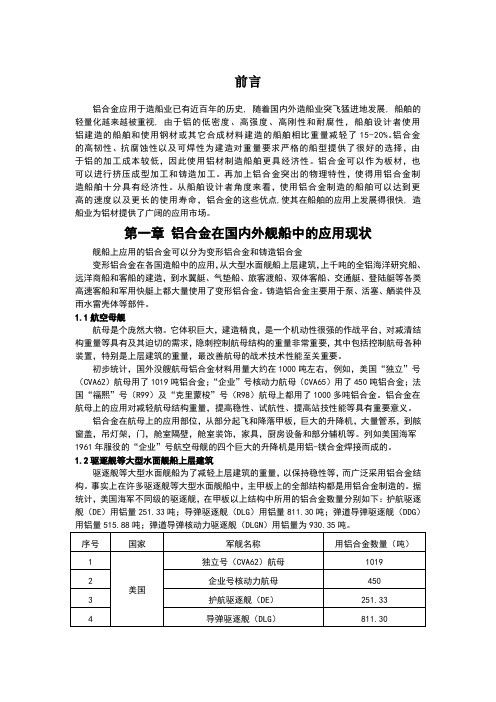
前言铝合金应用于造船业已有近百年的历史, 随着国内外造船业突飞猛进地发展, 船舶的轻量化越来越被重视, 由于铝的低密度、高强度、高刚性和耐腐性,船舶设计者使用铝建造的船舶和使用钢材或其它合成材料建造的船舶相比重量减轻了15-20%。
铝合金的高韧性、抗腐蚀性以及可焊性为建造对重量要求严格的船型提供了很好的选择,由于铝的加工成本较低,因此使用铝材制造船舶更具经济性。
铝合金可以作为板材,也可以进行挤压成型加工和铸造加工。
再加上铝合金突出的物理特性,使得用铝合金制造船舶十分具有经济性。
从船舶设计者角度来看,使用铝合金制造的船舶可以达到更高的速度以及更长的使用寿命,铝合金的这些优点,使其在船舶的应用上发展得很快, 造船业为铝材提供了广阔的应用市场。
第一章铝合金在国内外舰船中的应用现状舰船上应用的铝合金可以分为变形铝合金和铸造铝合金变形铝合金在各国造船中的应用,从大型水面舰船上层建筑,上千吨的全铝海洋研究船、远洋商船和客船的建造,到水翼艇、气垫船、旅客渡船、双体客船、交通艇、登陆艇等各类高速客船和军用快艇上都大量使用了变形铝合金。
铸造铝合金主要用于泵、活塞、舾装件及雨水雷壳体等部件。
1.1航空母舰航母是个庞然大物。
它体积巨大,建造精良,是一个机动性很强的作战平台,对减清结构重量等具有及其迫切的需求,隐刺控制航母结构的重量非常重要,其中包括控制航母各种装置,特别是上层建筑的重量,最改善航母的战术技术性能至关重要。
初步统计,国外没艘航母铝合金材料用量大约在1000吨左右,例如,美国“独立”号(CVA62)航母用了1019吨铝合金;“企业”号核动力航母(CVA65)用了450吨铝合金;法国“福熙”号(R99)及“克里蒙梭”号(R98)航母上都用了1000多吨铝合金。
铝合金在航母上的应用对减轻航母结构重量,提高稳性、试航性、提高站技性能等具有重要意义。
铝合金在航母上的应用部位,从部分起飞和降落甲板,巨大的升降机,大量管系,到舷窗盖,吊灯架,门,舱室隔壁,舱室装饰,家具,厨房设备和部分辅机等。
铝合金在船上的应用场景
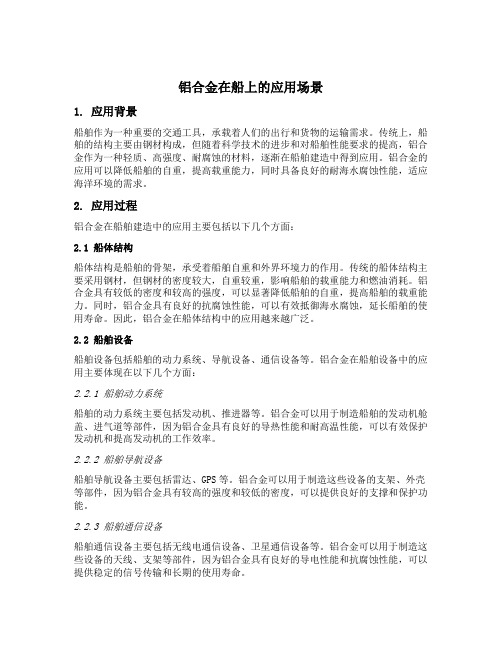
铝合金在船上的应用场景1. 应用背景船舶作为一种重要的交通工具,承载着人们的出行和货物的运输需求。
传统上,船舶的结构主要由钢材构成,但随着科学技术的进步和对船舶性能要求的提高,铝合金作为一种轻质、高强度、耐腐蚀的材料,逐渐在船舶建造中得到应用。
铝合金的应用可以降低船舶的自重,提高载重能力,同时具备良好的耐海水腐蚀性能,适应海洋环境的需求。
2. 应用过程铝合金在船舶建造中的应用主要包括以下几个方面:2.1 船体结构船体结构是船舶的骨架,承受着船舶自重和外界环境力的作用。
传统的船体结构主要采用钢材,但钢材的密度较大,自重较重,影响船舶的载重能力和燃油消耗。
铝合金具有较低的密度和较高的强度,可以显著降低船舶的自重,提高船舶的载重能力。
同时,铝合金具有良好的抗腐蚀性能,可以有效抵御海水腐蚀,延长船舶的使用寿命。
因此,铝合金在船体结构中的应用越来越广泛。
2.2 船舶设备船舶设备包括船舶的动力系统、导航设备、通信设备等。
铝合金在船舶设备中的应用主要体现在以下几个方面:2.2.1 船舶动力系统船舶的动力系统主要包括发动机、推进器等。
铝合金可以用于制造船舶的发动机舱盖、进气道等部件,因为铝合金具有良好的导热性能和耐高温性能,可以有效保护发动机和提高发动机的工作效率。
2.2.2 船舶导航设备船舶导航设备主要包括雷达、GPS等。
铝合金可以用于制造这些设备的支架、外壳等部件,因为铝合金具有较高的强度和较低的密度,可以提供良好的支撑和保护功能。
2.2.3 船舶通信设备船舶通信设备主要包括无线电通信设备、卫星通信设备等。
铝合金可以用于制造这些设备的天线、支架等部件,因为铝合金具有良好的导电性能和抗腐蚀性能,可以提供稳定的信号传输和长期的使用寿命。
2.3 船舶内部装饰船舶的内部装饰包括客舱、船舱、甲板等。
铝合金在船舶内部装饰中的应用主要体现在以下几个方面:2.3.1 船舱壁板船舱壁板是船舶内部装饰的重要组成部分,传统上主要采用木材或钢材制作。
铝船生产资质分级

铝船生产资质分级铝船是指以铝合金为主要材料制造的船舶。
铝船具有重量轻、强度高、耐腐蚀性好等优点,因此在船舶制造领域得到了广泛应用。
为了确保铝船的安全性和质量,各国制定了相应的生产资质分级标准。
一、铝船生产资质的分级概述铝船生产资质的分级主要是根据企业的生产能力、技术水平、质量管理体系等方面进行评定。
一般来说,铝船生产资质分为三级:一级资质、二级资质和三级资质。
二、一级资质一级资质是指具备较高生产能力和技术水平的企业所持有的资质。
一级资质的企业拥有完善的质量管理体系和先进的生产设备,能够生产高质量的铝船,并可以承担大型铝船的制造任务。
一级资质的企业通常具有较高的信誉度和市场竞争力,可以满足客户的各种需求。
三、二级资质二级资质是指具备一定生产能力和技术水平的企业所持有的资质。
二级资质的企业具有一定的质量管理体系和生产设备,能够生产中等质量的铝船,并可以承担中小型铝船的制造任务。
二级资质的企业在市场上有一定的竞争力,可以满足一般客户的需求。
四、三级资质三级资质是指具备基本生产能力和技术水平的企业所持有的资质。
三级资质的企业可能缺乏完善的质量管理体系和先进的生产设备,能够生产低质量的铝船,并可以承担小型铝船的制造任务。
三级资质的企业在市场上的竞争力相对较弱,只能满足一些简单的客户需求。
五、铝船生产资质的重要性铝船生产资质的分级对于保障铝船的质量和安全具有重要意义。
一级资质的企业具备较高的技术水平和生产能力,可以保证生产出高质量的铝船,从而提高船舶的安全性和可靠性。
而二级资质和三级资质的企业虽然生产能力和技术水平相对较低,但仍然能够满足一些客户的需求,为船舶市场提供了一定的选择空间。
六、铝船生产资质的获取途径要获取铝船生产资质,企业需要符合相关的技术标准和质量管理要求。
一般来说,企业需要通过申请和审核程序,提供相关的企业信息、技术资料和质量管理体系文件,以便相关部门对企业进行评定和认证。
评定合格后,企业即可获得相应的铝船生产资质。
- 1、下载文档前请自行甄别文档内容的完整性,平台不提供额外的编辑、内容补充、找答案等附加服务。
- 2、"仅部分预览"的文档,不可在线预览部分如存在完整性等问题,可反馈申请退款(可完整预览的文档不适用该条件!)。
- 3、如文档侵犯您的权益,请联系客服反馈,我们会尽快为您处理(人工客服工作时间:9:00-18:30)。
December 2003 Aluminum Boats Prove Their Mettle Reputation, Innovations Make Aluminum the Material of Choice of aGrowing Number of Boat BuildersByJohn SimpsonEditor, Aluminum NowandMichael SkillingbergVP, TechnologyThe Aluminum Association, Inc.Aluminum has been used in the marine industry for more than 100 years because of its light weight and ease of fabrication combined with good corrosion and fatigue resistance. However, for much of the past 30 years, fiberglass has been the material of choice of North American boatbuilders, particularly for higher-volume production lines. Competitively priced compared with boats made from most other materials, fiberglass boats can also be made from standardized molds that reduce their construction time and labor.Additionally, the claim has been made that fiberglass boats are "maintenance-free." However, as more has come to be understood about delamination, blistering, leaks, and problems associated with structural fatigue, this claim has proved to be untrue.Aluminum alloys, which are specified for marine use, suffer from none of these problems. Their high level of performance along with recent advances in aluminum cutting and welding is helping to reduce fiberglass' boats cost advantage, and the metal's utility for a wide range of boatbuilding applications is poised for reappraisal.Changing Image of Aluminum Boats"Aluminum boat technology is relatively new,"says Steve Daigle, president of Daigle Welding &Marine Ltd., in Campbell River, British Columbia,noting that welded aluminum boats first came onthe market en masse as recently as the late 1960s.Prior to that, riveting was the standard techniquefor joining aluminum sheets on boat hulls—atechnique still used for many smaller boats that usethinner-gauge aluminum.The image of a leaky, riveted runabout with ungainly lines persists for some people when picturing an aluminum boat. In fact, since the dawn of the welding age for aluminum boats, they have grown in stature to the point where they are the top choice in a number of categories of boats, including small recreational craft, small to medium-sized commercial fishing boats in the northwestern U.S., crew boats in the Gulf of Mexico, and fine yachts—both sail and motorized. Daigle himself notes that in just his 16 years in the boat business, the number of welded aluminum boat manufacturers in British Columbia has jumped from 6 to 24. But whether aluminum can make inroads into the large market for mid-sized recreational boats remains to be seen.Corrosion-Resistant AlloysCentral to aluminum's suitability for use in boat construction is the high resistance to corrosion of its alloys for marine applications when used in the specified corrosion resistant tempers. The traditional marine alloys—5083, 5086, and 5456 as well as the more recently developed 5383 and 5059—resist corrosion in fresh water and saltwater. A new specification ASTM B 928 “High Magnesium Aluminum-Alloy Sheet and Plate for Marine Service” has been developed to help in the selection of the appropriate alloy-temper products.Except for cosmetic reasons, 5xxx-series alloys don't even have to be painted above the waterline; the unpainted metal reacts with air (as would any other aluminum alloy) to form aluminum oxide—a hard, protective coating that protects the underlying aluminum. For most conditions the bottom of an aluminum hull needs only compatible antifouling paint to prevent the growth of performance-robbing barnacles and weeds and zinc anodes to prevent galvanic corrosion associated with non-aluminum metallic propulsion equipment and other attachments. Contrary to a common myth, with careful preparation and the application of proper primers and undercoats, aluminum holds paint very well.Steel—aluminum's other principal competitor as boat material—by contrast, rusts quickly in saltwater and thus requires protection inside and out. The interior of a steel hull is typically painted with coal-tar epoxy, and the exterior epoxy-coated or flame-sprayed with zinc or aluminum. For both jobs, the steel must be sandblasted with sharp silica sand to provide a tooth for the flame spray or paint. This substantial, dirty, and expensive task can offset the higher material cost of the aluminum to a large degree.Easily WeldedAluminum alloys used for hull construction—commonly 5086 and 5083—are also easy to weld. Hull plating of 3/16 of an inch and above easily accommodates MIG (metal inert gas) welding for much of the basic construction, with TIG (tungsten inert gas) welding appropriate for the more detailed work, such as attachments. What's more, advancements in welding equipment have also made this less of a chore than it used to be by using less heat, thus distorting the metal less when it is being joined. This results in welds which can be made more easily and more precisely.2now use nothing but Pulse MIGs," says JackWinninghoff, president and owner ofWinninghoff Boats, Inc., in Rowley, Mass.Pulse MIGs, which use a computer to create acontrollable square wave pulse, are capable ofproviding smoother welds with greaterpenetration into the metal for a more pleasingappearance. Winninghoff describes the PulseMIGs of the past four to five years as "a heckuva lot better—the welder has better control and can work faster," cutting an estimated 15 percent of the labor time.Unlike fiberglass, which cannot be welded, aluminum is quick and relatively easy to weld under most conditions. Highly shapeable, the metal lends itself to sculptured detailing with soft shapes and edges—allowing for the more attractive lines of today's aluminum craft. More easily machined than steel, aluminum can even be cut with common carpentry tools—a router and saber, circular, and band saws—rather than a torch. In addition, hull fittings such as bait tank pumps and depth finders can be installed by simply drilling and tapping into the hull with a stainless steel fastener.Here again, however, computers are starting to revolutionize this aspect of the aluminum boatbuilding business, with cost-saving results. Both custom and production boatbuilders can now create hull designs with three-dimensional CAD (computer-aided design) software that can be fed directly to a computer-controlled cutting table, making for uniform, more quickly cut, pieces. Ease of cutting and welding is a factor not only during the construction process, but also for repairs and remodeling. Since aluminum boats are not built from molds, changes in design, altering the location of bulkheads, resizing cabins, etc., are all accomplished more easily than on fiberglass boats. Equipment can also be relocated more easily on an aluminum boat—by cutting and welding or drilling and bolting—than on fiberglass.More Durable Than Steel, FiberglassAs for durability and reparability: aluminum comes outahead of both steel and fiberglass. Compared with asteel hull, a "strength-equivalent" aluminum hull (i.e.,built to the same stiffness) boasts about 29 percentgreater dent resistance and 12.5 percent greaterresistance to rupture, according to Michael Kasten, ofKasten Marine Design, Inc., of Port Townsend, Wash.(Such an aluminum hull would be approximately 50percent thicker, but lighter, than its steel counterpart, due to aluminum's lighter physical property.) Fiberglass, on the other hand, is extremely brittleand far more likely than either aluminum or steel to rupture upon impact.3Due to the metal's ductility, when an aluminum boat does sustain a dent, it can often be pounded out with a hammer or, if necessary, cut out with a saw and easily replaced. Tales abound of aluminum boats stranded on rocks for days, absorbing blow after blow against their hull, denting—but not rupturing—and being towed to a yard where their damaged sections are cut away and replaced, so the boat could be returned to service. In such instances, if a fiberglass boat did not sink on the spot, its damage would likely render it too costly to repair.With regard to flammability, aluminum does not burn and requires a temperature of over 1000°F to melt. Further, aluminum boats can be easily fitted to provide "structural fire protection," i.e., containment of fire in a particular compartment by the craft's structure without help from firefighting systems. Fiberglass, on the other hand, frequently contains petroleum-based resins that can burn energetically once started. And, while watertight bulkheads can be built in such fiberglass boats, structural fire protection may not be achievable due to the material's flammability.Lightness + Strength = VersatilityAn aluminum boat of a strength equal to a comparably designed steel or fiberglass boat will weigh less by approximately 20 percent or more. In fact, weight savings of 35% to 45% in hulls, and 55% to 65% in superstructures, can be achieved with aluminum compared to steel. Put another way, pound for pound aluminum is stronger than either material.Aluminum's weight advantage means that an aluminum craft of comparable design and equal strength will generally move more quickly if sail driven, use less fuel if motor-driven, be able to accommodate a heavier cargo, and be more easily trailerable than its steel and fiberglass counterparts. Higher vessel speeds and load capacities, enabled by use of aluminum, attract extra traffic volume and profit for the ferry operator. The use of aluminum can also improve seaworthiness, safety, and reliability, and lower maintenance costs.So why isn't the aluminum boat king?Consider a Boat's Lifetime CostsUp-front costs for a fiberglass boat willalmost always be cheaper than forcomparable steel or aluminum craft(although plasma cutting machines, usedby many aluminum boatbuilders, havestarted to eat into this margin). But whenthe costs of routine maintenance—corrosion control, painting, and repaintingfor steel boats—as well as majorrepairs—leaks, cracks, and problemsstemming from structural fatigue infiberglass—are factored in, aluminum becomes more price-competitive with both materials. What's more, aluminum boats typically last longer than comparable steel or fiberglass boats and,4on average command a higher resale price—both highly relevant when considering a boat's "cost."One final important difference distinguishing aluminum boats from fiberglass is the known consistent quality of the material. Aluminum manufacturing facilities' operations are certified to one or more ISO standards, notes Daigle, the Canadian builder. And the aluminum that they produce conforms to one or more ASTM and/or Aluminum Association standards."There's a huge quality-control process that goes through to the end manufacturer," Daigle comments. However, it is important that the aluminum alloys and other components are purchased to the appropriate material specification (such as the new ASTM B 928) and that proper design and fabrication methods are employed and the appropriate classification society guidelines are followed. Good communication between the naval architects, boat builders and material suppliers helps to ensure that the boat owner will be able to enjoy the full range of performance advantages over the life of his aluminum craft.With fiberglass, any number of vastly-different-quality resins may be used whose performance and durability can vary widely. While aluminum welds can be x-rayed for verification of a boat hull's integrity, an entire section of fiberglass would have to be excised and essentially destroyed to subject it to analysis.All told, aluminum boats offer significant advantages over the competition with regard to their weight, strength, durability, the maintenance they require, and their resale value. And, if your aluminum boat bucks the odds and winds up headed for the scrap heat, take heart; it's also highly recyclable.For information on aluminum products for the marine market you can visit the web sites of the following aluminum producer companies:Alcan Inc. -/index.html?menuID=2&segmentID=10&action=segment Alcoa Inc. - /global/en/about_alcoa/businesses/alcoa_mill_prod.asp Corus Aluminium Rolled Products - http://www.corusgroup-/english/products/shipbuilding/index.htmKaiser Aluminum & Chemical Corp. - /kaiser/kaisermain.nsf Pechiney Rolled Products - /is-bin/INTERSHOP.enfinity/eTS/Store/-/-/-/Marine_Storefront-Start?Activite=Marine5Many aluminum products for marine applications are also available through the distribution network. The Metal Service Center Institute web site (/sitemap.adp ) can help to direct you to a distributor in your area.6。
